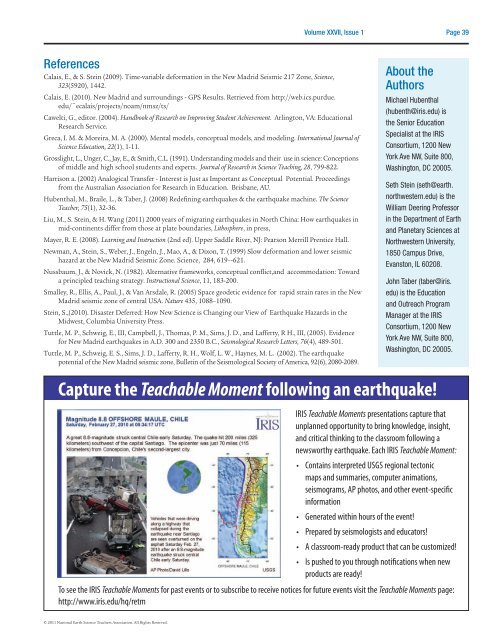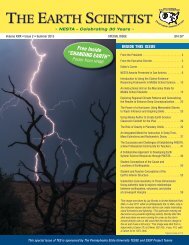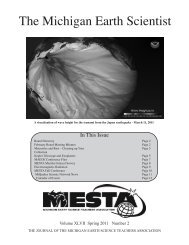The Earth Scientist
The earTh ScienTiST - NESTA
The earTh ScienTiST - NESTA
Create successful ePaper yourself
Turn your PDF publications into a flip-book with our unique Google optimized e-Paper software.
Volume XXVII, Issue 1<br />
Page 39<br />
References<br />
Calais, E., & S. Stein (2009). Time-variable deformation in the New Madrid Seismic 217 Zone, Science,<br />
323(5920), 1442.<br />
Calais, E. (2010). New Madrid and surroundings - GPS Results. Retrieved from http://web.ics.purdue.<br />
edu/~ecalais/projects/noam/nmsz/ts/<br />
Cawelti, G., editor. (2004). Handbook of Research on Improving Student Achievement. Arlington, VA: Educational<br />
Research Service.<br />
Greca, I. M. & Moreira, M. A. (2000). Mental models, conceptual models, and modeling. International Journal of<br />
Science Education, 22(1), 1-11.<br />
Grosslight, L., Unger, C., Jay, E., & Smith, C.L. (1991). Understanding models and their use in science: Conceptions<br />
of middle and high school students and experts. Journal of Research in Science Teaching, 28, 799-822.<br />
Harrison a. (2002) Analogical Transfer - Interest is Just as Important as Conceptual Potential. Proceedings<br />
from the Australian Association for Research in Education. Brisbane, AU.<br />
Hubenthal, M., Braile, L., & Taber, J. (2008) Redefining earthquakes & the earthquake machine. <strong>The</strong> Science<br />
Teacher, 75(1), 32-36.<br />
Liu, M., S. Stein, & H. Wang (2011) 2000 years of migrating earthquakes in North China: How earthquakes in<br />
mid-continents differ from those at plate boundaries, Lithosphere, in press,<br />
Mayer, R. E. (2008). Learning and Instruction (2nd ed). Upper Saddle River, NJ: Pearson Merrill Prentice Hall.<br />
Newman, A., Stein, S., Weber, J., Engeln, J., Mao, A., & Dixon, T. (1999) Slow deformation and lower seismic<br />
hazard at the New Madrid Seismic Zone. Science, 284, 619–-621.<br />
Nussbaum, J., & Novick, N. (1982). Alternative frameworks, conceptual conflict,and accommodation: Toward<br />
a principled teaching strategy. Instructional Science, 11, 183-200.<br />
Smalley, R., Ellis, A., Paul, J., & Van Arsdale, R. (2005) Space geodetic evidence for rapid strain rates in the New<br />
Madrid seismic zone of central USA. Nature 435, 1088–1090.<br />
Stein, S.,(2010). Disaster Deferred: How New Science is Changing our View of <strong>Earth</strong>quake Hazards in the<br />
Midwest, Columbia University Press.<br />
Tuttle, M. P., Schweig, E., III, Campbell, J., Thomas, P. M., Sims, J. D., and Lafferty, R H., III, (2005). Evidence<br />
for New Madrid earthquakes in A.D. 300 and 2350 B.C., Seismological Research Letters, 76(4), 489-501.<br />
Tuttle, M. P., Schweig, E. S., Sims, J. D., Lafferty, R. H., Wolf, L. W., Haynes, M. L. (2002). <strong>The</strong> earthquake<br />
potential of the New Madrid seismic zone, Bulletin of the Seismological Society of America, 92(6), 2080-2089.<br />
About the<br />
Authors<br />
Michael Hubenthal<br />
(hubenth@iris.edu) is<br />
the Senior Education<br />
Specialist at the IRIS<br />
Consortium, 1200 New<br />
York Ave NW, Suite 800,<br />
Washington, DC 20005.<br />
Seth Stein (seth@earth.<br />
northwestern.edu) is the<br />
William Deering Professor<br />
in the Department of <strong>Earth</strong><br />
and Planetary Sciences at<br />
Northwestern University,<br />
1850 Campus Drive,<br />
Evanston, IL 60208.<br />
John Taber (taber@iris.<br />
edu) is the Education<br />
and Outreach Program<br />
Manager at the IRIS<br />
Consortium, 1200 New<br />
York Ave NW, Suite 800,<br />
Washington, DC 20005.<br />
Capture the Teachable Moment following an earthquake!<br />
IRIS Teachable Moments presentations capture that<br />
unplanned opportunity to bring knowledge, insight,<br />
and critical thinking to the classroom following a<br />
newsworthy earthquake. Each IRIS Teachable Moment:<br />
• Contains interpreted USGS regional tectonic<br />
maps and summaries, computer animations,<br />
seismograms, AP photos, and other event-specific<br />
information<br />
• Generated within hours of the event!<br />
• Prepared by seismologists and educators!<br />
• A classroom-ready product that can be customized!<br />
• Is pushed to you through notifications when new<br />
products are ready!<br />
To see the IRIS Teachable Moments for past events or to subscribe to receive notices for future events visit the Teachable Moments page:<br />
http://www.iris.edu/hq/retm<br />
© 2011 National <strong>Earth</strong> Science Teachers Association. All Rights Reserved.






